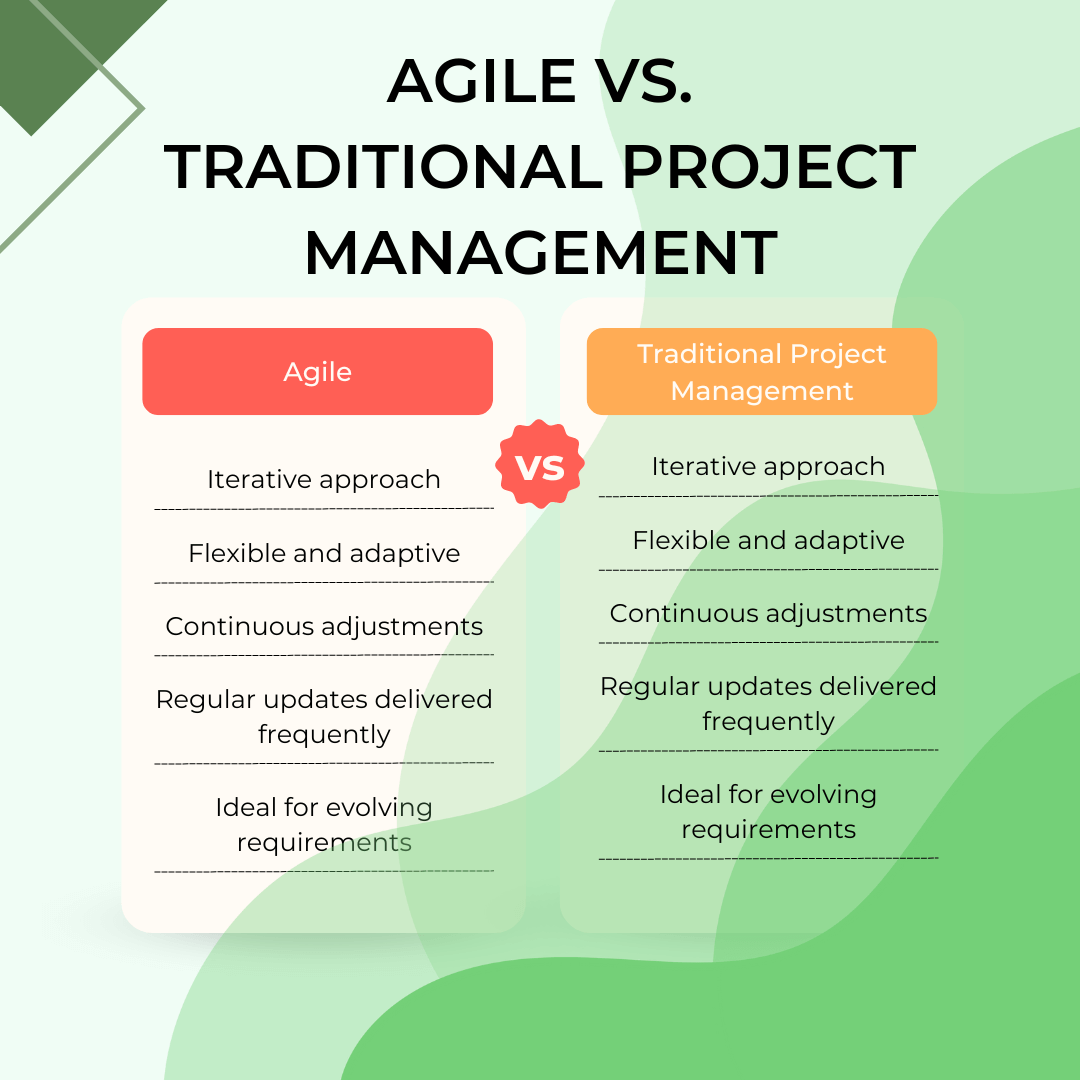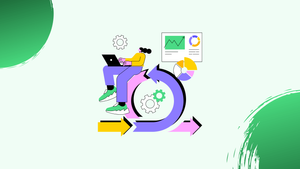Introduction
Modernizing applications can be daunting, often hampered by lengthy timelines and inflexible processes. Traditional methods struggle to keep pace with evolving business needs and technological advancements.
Agile methodology offers a solution, enabling iterative development and continuous feedback to streamline application modernization. This article explores how Agile can accelerate your modernization efforts, improve adaptability, and ensure that your applications meet current and future demands efficiently.
What is Agile Methodology?
Agile methodology offers a contemporary approach to project management, emphasizing adaptability, teamwork, and incremental development.
Agile is a set of principles and practices aimed at delivering projects in small, manageable increments. It values adaptability and customer feedback over rigid processes and comprehensive upfront planning.
The methodology was formalized with the publication of the Agile Manifesto in 2001, which outlined four core values and twelve principles that emphasize iterative progress and responsiveness to change.
Agile vs. Traditional Project Management
When choosing a project management approach, understanding the key differences between Agile and traditional methods is crucial.
Traditional Project Management (Waterfall) adopts a linear, step-by-step approach, where projects are meticulously planned from beginning to end, with each phase needing completion before progressing to the next. This approach is effective for projects that have well-established requirements and a clear, direct route to completion. However, its rigidity can be a drawback when facing changes or unforeseen issues, leading to potential delays and higher costs.
Agile Methodology, in contrast, emphasizes flexibility and iterative progress. Projects are broken down into smaller, manageable increments called sprints, with continuous feedback and adjustments. This approach fosters collaboration and allows teams to adapt to changes quickly, enhancing responsiveness and customer satisfaction. Agile suits projects with evolving requirements or those in dynamic environments where rapid changes are common.
Benefits of Agile include improved team collaboration, faster delivery of functional increments, and better alignment with customer needs through regular feedback. It also promotes a more adaptive workflow, which can significantly reduce the risk of project failure.
When Agile is Preferable: Agile is ideal for projects in fast-changing industries or those where requirements are expected to evolve. Its iterative nature helps in accommodating changes and delivering value early and often.
When Agile May Not Be Suitable: Agile may not be ideal for projects with rigid requirements and strict regulatory constraints. In such cases, the structured and predictable nature of traditional methods may be more effective.
Choosing between Agile and traditional project management depends on the project’s needs, goals, and environment. Understanding these approaches helps in selecting the most effective method for achieving successful outcomes.

Core Principles of Agile
Agile methodology is grounded in a set of core principles designed to enhance flexibility, collaboration, and efficiency in project management. Understanding these principles is essential for leveraging Agile effectively.
The Agile Manifesto articulates four key values and twelve guiding principles. The values emphasize:
- Individuals and Interactions Over Processes and Tools: Prioritizing people and communication over rigid procedures ensures that teams remain adaptable and responsive.
- Working Software Over Comprehensive Documentation: Delivering functional products frequently is more valuable than exhaustive documentation, allowing teams to focus on real progress.
- Customer Collaboration Over Contract Negotiation: Continuous engagement with customers ensures that the end product meets their evolving needs rather than adhering strictly to initial contracts.
- Responding to Change Over Following a Plan: Embracing changes in requirements, even late in development, fosters a more relevant and effective product.
Agile Frameworks embody these principles through various methodologies, including:
- Scrum: Focuses on iterative development with defined roles (Scrum Master, Product Owner, Development Team) and time-boxed sprints, facilitating regular feedback and continuous improvement.
- Kanban: Uses visual boards to manage workflow, emphasizing continuous delivery and incremental improvements without fixed iterations.
- Lean: Aims to maximize value by minimizing waste and optimizing processes, inspired by lean manufacturing principles.
Each framework offers unique strengths, making Agile adaptable to different project types and environments. By aligning with the Agile Manifesto's principles and selecting an appropriate framework, teams can achieve greater flexibility, improved collaboration, and more effective project outcomes.
Implementing Agile in Your Organization
Successfully adopting Agile requires careful planning and adaptation. Following is a simple and practical guide to smoothly handle this transition.
Preparing for Agile Transition involves several key steps:
- Assess Organizational Readiness: Evaluate current processes, culture, and willingness to change. Identify challenges and areas that could use further development.
- Develop a Transition Plan: Create a detailed roadmap outlining the steps to implement Agile, including training, tool adoption, and process adjustments.
- Communicate Change: Ensure that all stakeholders understand the benefits of Agile and are prepared for the shift. Clear communication helps in managing expectations and minimizing resistance.
Role of Leadership and Team Dynamics is crucial for Agile success:
- Leadership’s Role: Leaders should champion Agile practices, provide support, and address any obstacles. Their commitment helps drive organizational change and reinforces Agile values.
- Building Agile Teams: Form cross-functional teams that are self-organizing and collaborative. Inspire team members to take ownership of their work and make informed decisions.
- Fostering Collaboration: Encourage open communication and regular feedback within teams and with stakeholders. Agile thrives on active collaboration and transparency.
Common Challenges and Solutions
- Resistance to Change: Some employees may resist Agile due to unfamiliarity or fear of losing control. Address concerns through education, and involve them in the transition process.
- Skill Gaps: Ensure team members receive adequate training on Agile practices and tools. Consider hiring experienced Agile practitioners if necessary.
- Misalignment with Organizational Culture: Align Agile practices with the existing culture or work towards evolving the culture to support Agile principles. Achieving this alignment is essential for sustained success.
Implementing Agile effectively requires a thoughtful approach, strong leadership, and a supportive team environment. By addressing these areas, organizations can successfully transition to Agile and reap its benefits.
Common Misconceptions and Pitfalls
Adopting Agile can be challenging due to various misconceptions and pitfalls. Understanding these can help organizations avoid common mistakes and ensure a smoother implementation.
Debunking Myths About Agile:
- Agile Means No Planning: A common misconception is that Agile lacks structure and planning. In reality, Agile involves continuous planning and iterative progress, with planning adapting to evolving requirements.
- Agile is Only for Software Development: While Agile originated in software, its principles apply to a wide range of industries, including marketing, product management, and even construction.
- Agile Guarantees Faster Results: Agile promotes incremental delivery but does not guarantee faster results. Its focus is on delivering value regularly and adapting based on feedback, which can lead to more effective outcomes over time.
Hidden Costs and Challenges:
- Training and Change Management: Implementing Agile often involves significant costs related to training teams and managing organizational change. This includes time and resources for education and potential disruptions during the transition.
- Initial Productivity Decline: Teams may experience a temporary drop in productivity as they adapt to new processes and roles. This is a normal part of the transition, and the focus should be on long-term gains rather than short-term performance.
- Ongoing Maintenance and Adaptation: Agile requires continuous adjustment and refinement. Organizations must be prepared for ongoing efforts to optimize processes, address issues, and keep the Agile practices aligned with evolving needs.
By addressing these misconceptions and preparing for hidden costs, organizations can better manage their Agile adoption and avoid common pitfalls. Embracing Agile with a clear understanding of its requirements and challenges will help in achieving more effective and sustainable results.
Measuring Agile Success
Evaluating the effectiveness of Agile methodologies involves tracking various metrics and continuously improving practices. Here’s how to measure Agile success and ensure ongoing enhancement.
Key Performance Indicators (KPIs):
- Velocity: Assesses the volume of tasks a team finishes within each sprint. Tracking velocity helps gauge team capacity and predict future performance, although it should be used in conjunction with other metrics to avoid a narrow focus on speed.
- Lead Time and Cycle Time: Lead time tracks the period from when work starts to its completion, whereas cycle time measures the duration from the start of work to its delivery. Both metrics provide insights into efficiency and areas for process improvement.
- Customer Satisfaction: Regular feedback from customers and stakeholders indicates how well the Agile team meets their needs. High satisfaction scores reflect successful alignment with customer expectations and effective delivery.
Continuous Improvement:
- Retrospectives: These meetings are essential for recognizing and resolving issues, while promoting a culture of continuous learning. These meetings play a key role in recognizing and resolving problems while promoting a culture of ongoing learning.
- Process Adjustments: Based on feedback and performance data, teams should be willing to adjust their workflows, tools, and practices. Agile’s iterative nature allows for ongoing refinement and adaptation to enhance overall effectiveness.
By focusing on these KPIs and committing to continuous improvement, organizations can effectively measure Agile success and drive meaningful progress. Regular assessments ensure that Agile practices remain aligned with project goals and deliver valuable outcomes.
Case Studies and Real-World Applications
Examining real-world applications of Agile provides valuable insights into its effectiveness and versatility across different industries. Here are notable case studies highlighting Agile’s impact.
Successful Agile Implementations:
- IT Industry: In a major tech company, Agile practices led to a 30% increase in productivity and a 40% reduction in time-to-market for software releases. By implementing Scrum, the team was able to deliver features more frequently and respond to user feedback promptly, improving overall customer satisfaction.
- Healthcare Sector: A healthcare provider adopted Agile to streamline its electronic health records system. Using Kanban, the team reduced development cycle times and improved system reliability, leading to faster updates and better integration with existing processes.
Lessons Learned and Best Practices:
- Flexibility and Adaptation: Agile's iterative approach allowed these organizations to quickly adapt to changes and unforeseen challenges. Emphasizing flexibility and frequent feedback helped in aligning projects more closely with evolving needs and market conditions.
- Cross-Functional Teams: Successful implementations often featured cross-functional teams with diverse skills working collaboratively. This setup enhanced problem-solving and innovation, demonstrating the value of Agile’s emphasis on team collaboration.
Failed Agile Projects:
- Challenges in Scaling: In a large multinational corporation, Agile adoption faced hurdles due to difficulties in scaling practices across multiple departments. Misalignment between teams and inadequate training led to inconsistent application of Agile principles, resulting in project delays.
- Resistance to Change: Another organization struggled with Agile due to strong resistance from long-standing employees who were accustomed to traditional methods. This resistance hindered effective implementation and led to suboptimal outcomes.
These case studies illustrate that while Agile can drive significant improvements, success depends on careful implementation, team alignment, and ongoing support. Learning from both successes and failures helps in refining Agile practices and achieving better results.
Future Trends
The future of Agile is shaped by emerging trends and evolving practices that continue to transform project management. Staying informed about these developments can help organizations maintain a competitive edge and adapt to changing environments.
Emerging Trends and Innovations:
- Integration with AI and Automation: Agile is increasingly incorporating artificial intelligence and automation tools to enhance efficiency and decision-making. AI-driven analytics provide deeper insights into project performance, while automation tools streamline repetitive tasks, allowing teams to focus on higher-value activities.
- Remote and Distributed Teams: The rise of remote work has influenced Agile practices, leading to greater emphasis on tools and techniques that facilitate collaboration across distributed teams. Virtual Agile boards, video conferencing, and asynchronous communication are becoming integral to maintaining productivity and cohesion in a remote setting.
Evolving Frameworks and Practices:
- Scaled Agile Frameworks: As organizations grow, scaling Agile practices to larger teams and multiple departments has become a priority. Frameworks like SAFe (Scaled Agile Framework) and LeSS (Large Scale Scrum) offer structured approaches for implementing Agile at scale, addressing complexities and improving coordination across large projects.
- Agile Beyond IT: Agile principles are extending beyond IT and software development into other areas such as marketing, HR, and finance. This cross-industry adoption highlights Agile’s flexibility and effectiveness in diverse organizational contexts, promoting iterative approaches and continuous improvement in various functions.
The future of Agile is marked by increased integration with technology, adaptation to new work environments, and broader application across industries. Embracing these trends will help organizations leverage Agile’s benefits and drive innovation in an ever-evolving landscape.
Key Takeaways
- Agile Principles: Focus on flexibility, collaboration, and iterative progress. Key values include prioritizing individuals and interactions over processes and adapting to change.
- Agile vs. Traditional: Agile emphasizes iterative development and customer feedback, while traditional methods follow a linear, fixed-plan approach. Agile suits dynamic environments, whereas traditional methods work better for projects with stable requirements.
- Implementation Challenges: Successful Agile adoption requires preparation, strong leadership, and addressing resistance to change. Training and alignment with organizational culture are crucial for a smooth transition.
- Measuring Success: Key metrics include velocity, lead and cycle times, and customer satisfaction. Continuous improvement through retrospectives and process adjustments is essential for ongoing success.
- Future Trends: Agile is evolving with AI integration, remote team collaboration, and broader application across various industries. Emerging frameworks and practices aim to scale Agile effectively and adapt to new work environments.
Conclusion
Agile methodology transforms project management through flexibility, iterative progress, and collaboration. It’s essential for adapting to change and delivering value across various industries. Successful implementation requires overcoming misconceptions, managing hidden costs, and continuously evaluating practices.
The future of Agile involves integrating emerging technologies, adapting to remote work, and expanding its use across different sectors. Embracing these trends and refining Agile practices can lead to significant productivity gains and improved customer satisfaction.

